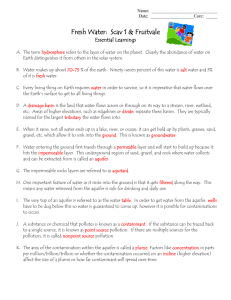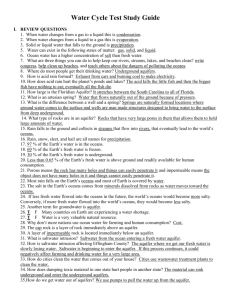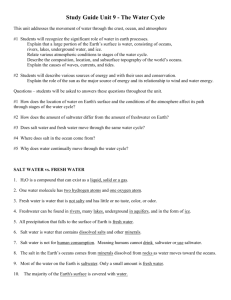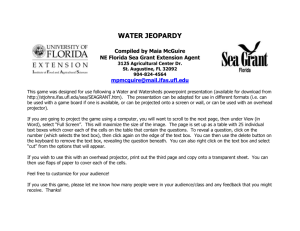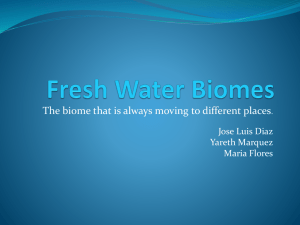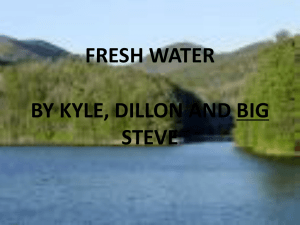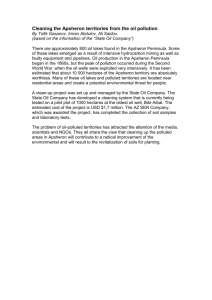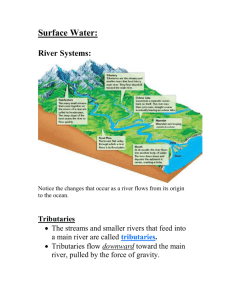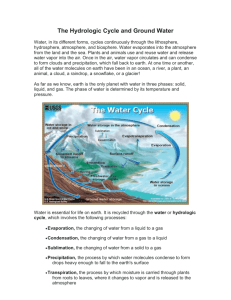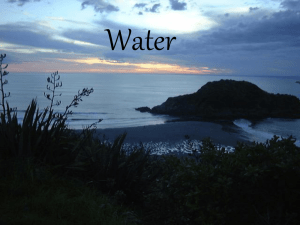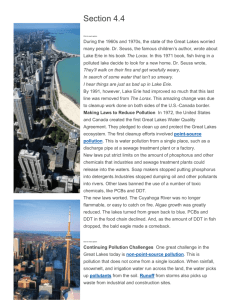Fresh Water Notes Ch 12 - Stephanie Dietterle Webpage
advertisement
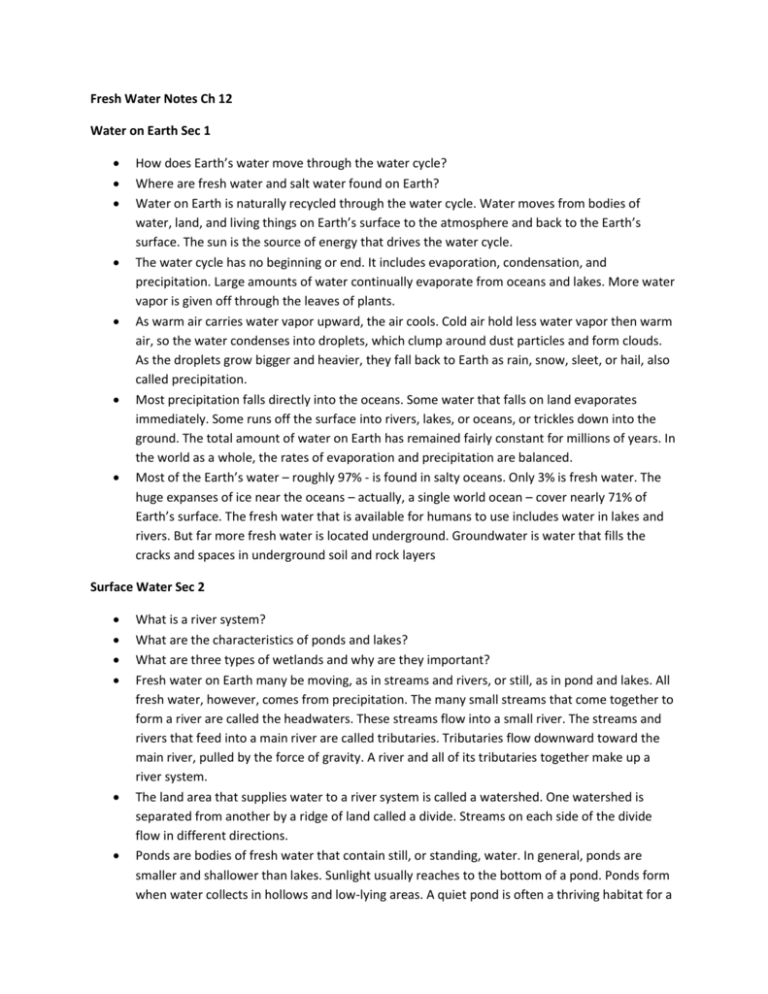
Fresh Water Notes Ch 12 Water on Earth Sec 1 How does Earth’s water move through the water cycle? Where are fresh water and salt water found on Earth? Water on Earth is naturally recycled through the water cycle. Water moves from bodies of water, land, and living things on Earth’s surface to the atmosphere and back to the Earth’s surface. The sun is the source of energy that drives the water cycle. The water cycle has no beginning or end. It includes evaporation, condensation, and precipitation. Large amounts of water continually evaporate from oceans and lakes. More water vapor is given off through the leaves of plants. As warm air carries water vapor upward, the air cools. Cold air hold less water vapor then warm air, so the water condenses into droplets, which clump around dust particles and form clouds. As the droplets grow bigger and heavier, they fall back to Earth as rain, snow, sleet, or hail, also called precipitation. Most precipitation falls directly into the oceans. Some water that falls on land evaporates immediately. Some runs off the surface into rivers, lakes, or oceans, or trickles down into the ground. The total amount of water on Earth has remained fairly constant for millions of years. In the world as a whole, the rates of evaporation and precipitation are balanced. Most of the Earth’s water – roughly 97% - is found in salty oceans. Only 3% is fresh water. The huge expanses of ice near the oceans – actually, a single world ocean – cover nearly 71% of Earth’s surface. The fresh water that is available for humans to use includes water in lakes and rivers. But far more fresh water is located underground. Groundwater is water that fills the cracks and spaces in underground soil and rock layers Surface Water Sec 2 What is a river system? What are the characteristics of ponds and lakes? What are three types of wetlands and why are they important? Fresh water on Earth many be moving, as in streams and rivers, or still, as in pond and lakes. All fresh water, however, comes from precipitation. The many small streams that come together to form a river are called the headwaters. These streams flow into a small river. The streams and rivers that feed into a main river are called tributaries. Tributaries flow downward toward the main river, pulled by the force of gravity. A river and all of its tributaries together make up a river system. The land area that supplies water to a river system is called a watershed. One watershed is separated from another by a ridge of land called a divide. Streams on each side of the divide flow in different directions. Ponds are bodies of fresh water that contain still, or standing, water. In general, ponds are smaller and shallower than lakes. Sunlight usually reaches to the bottom of a pond. Ponds form when water collects in hollows and low-lying areas. A quiet pond is often a thriving habitat for a wide diversity of living things. A habitat is the place where an organism lives and obtains the things it needs to survive. Lakes are generally deeper and bigger than ponds. In addition, sunlight does not reach the bottom in a deep lake, as it does in a pond. Some lakes may form through the same processes that form ponds. Larger lakes are often the result of powerful forces that shape Earth’s surface. A lake that stores water for human use is called a reservoir. A wetland is an area of land that is covered with a shallow layer of water during some or all of the year. The three common types of freshwater wetlands are marshes, swamps, and bogs. Marshes are generally grassy, while swamps contain trees and shrubs. Bogs generally are characterized by many types of mosses. Coastal wetlands, such as salt marshes are mangrove forests, usually contain a mixture of fresh and salt water. The Everglades is a huge marsh in southern Florida. Although it is a habitat for many rare and endangered species, the wetlands is threatened by human activities. Because of their sheltered waters and rich supply of nutrients, wetlands provide habitats for many living things. Wetlands have important functions for people, as well as for wildlife. As water moves slowly through wetlands, solid materials settle out. Other wastes are absorbed by the plants. The plant’s roots also trap mud and silt. In this way, wetlands act as natural water filters. They also help control floods by absorbing extra runoff from heavy rains. Water Underground Sec 3 How does water move through underground layers of soil and rock? How do people obtain water from an aquifer? Underground water comes from precipitation that soaks into the ground. The water underground trickles down between particles of soil and through cracks and spaces in layers of rock. Different types of rock and soil have different-sized spaces, or pores, between their particles. Materials that allow water to pass through easily are called permeable. Materials that do not allow water to pass through easily are called impermeable. When water soaks down into the ground, it passes through permeable materials. Eventually it reaches an impermeable layer. These, it stops trickling down and begins to fill the spaces in the permeable layer above it. The permeable layer that becomes filled with water is called the saturated zone. The level of the top of the water in the saturated zone is called the water table. The layer of rocks and soil above the water table is called the unsaturated zone. In some places, the water table reaches the surface. A spring is a place where groundwater bubbles or flows out of cracks in the rock. An aquifer is an underground layer of rock or sediment where water has collected. The water in an aquifer seeps through the permeable rock layers where it is stored. People can obtain groundwater from an aquifer by drilling a well below the water table. Pumping water out of an aquifer lowers the water level near the well. The aquifer refills when new water from the surface, called recharge, enters the aquifer. In some aquifers, the water that has collected between impermeable layers is under great pressure. If a hole is drilled in the impermeable layer above it, the water flows out of the aquifer without being pumped. A well in which water rises because of pressure within the aquifer is called an artesian well. The water in some springs is warm or even hot. The water is heated by hot rocks deep underground. A geyser is a hot spring in which the water is under pressure. From time to time, the pressure causes the hot water and steam to erupt into the air. Using Freshwater Resources Sec 4 How do people use water? What are some ways to conserve available fresh water? How do scientists classify sources of water pollution? People use water for household purposes, industry, agriculture, transportation, and recreation. As you know, water is constantly recycled in the water cycle. However, sometimes water is used faster than it can be replaced by precipitation. A water shortage occurs when there is too little water or too great demand on an area – or both. A water shortage may occur because of natural processes, or it can occur because of rapidly growing human needs. Think of all the ways water is used in the home. There are many demands on water for home use. Industries use water. For example, power plants and steel mills need huge volumes of water to cool hot machinery. Water has also been used to transport people and goods since ancient times. If you look at a map of the US, you will notice that many large cities are located on coasts. Ocean travel led to the growth of these port cities. In early America, rivers also served as natural highways. Water is also need for agriculture. However, some areas don’t receive enough regular rainfall for agriculture. In such places, farmland must be irrigated. Irrigation is the process of supplying water to areas of land to make them suitable for growing crops. During a water shortage, people often try to avoid wasting water. Conservation is the practice of using less of a resource of that it will not be used up. Reducing water use, recycling water, and reusing water are three ways to conserve water. The addition of any substance that has a negative effect on water or the living things that depend on water is called water pollution. Water pollution can affect surface water, groundwater, and even precipitation. The substances that cause water pollution are called pollutants. Sources of pollution are classified, in part, on how they enter a body of water. A point source is a specific source of pollution that can be identified, such as a leaking pipe. A nonpoint source is a widely spread source of pollution that can’t be tied to a specific point of origin, such as runoff from a highway. There are many ways in which industries, farms, and homes can reduce water pollution. Water to Drink Sec 5 What factors affect water quality? Why is drinking water often treated before people drink it? Water quality is a measurement of those substances in water other then water molecules. Some substances, such as iron, can affect the taste or color of water but are harmless unless present at very high levels. Other substances, such as certain chemicals and microorganisms, can be harmful to health. In the US, the Environmental Protection Agency (EPA) is responsible for developing water-quality standards. These standards set concentration limits for certain substances. A concentration is the amount of one substance in a certain volume of another substance. The pH level of water also affects its quality. The pH of water is a measurement of how acidic or basic the water is, on a scale of 0 to 14. Pure water has a pH of 7 – it is neutral, meaning that it is neither an acid nor a base. The combined level of two minerals, calcium and magnesium, in a sample of water is referred to as the hardness of that sample. Hard water contains high levels of calcium and magnesium. Soft water, on the other hand, contains lower levels of calcium and magnesium. How can you be sure that the quality of water is good? Water from both public and private supplies often needs some treatment to ensure that it is clean and safe to drink. The first step in treating water from a lake is usually filtration. Filtration is the process of passing water through a series of screens that allow the water through, but not larger, solid particles. In the second step, a chemical such as alum is added to cause sticky globs, called flocs, to form. Other particles in the water stick to the flocs in a process called coagulation. The heavy clumps sink to the bottom in the settling basins. The water is then filtered again.
